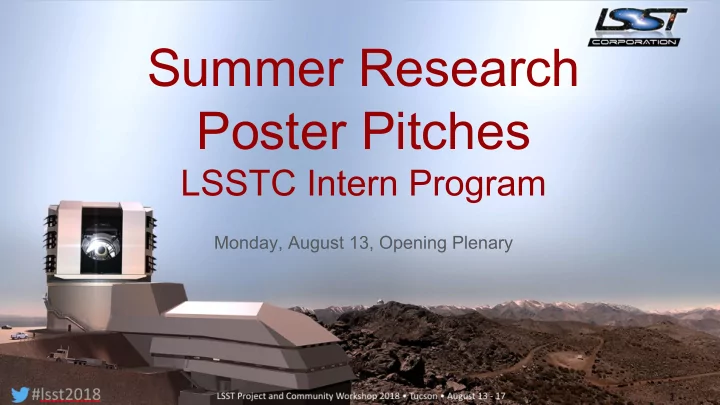

Summer Research Poster Pitches LSSTC Intern Program Monday, August 13, Opening Plenary
Nicole Arredondo, Grinnell College Fermilab Center for Particle Astrophysics Advisor: James Annis Research question: What can cross-correlation techniques tell us about galaxy-cluster membership and boost factor? Outcomes: Cross-correlations show leakage in photometric redshift catalog which impact cluster membership assignment and cluster mass calculations. ___________________________________________________________________________________________________________________________________________ Participant in the LSST Corporation’s Summer 2018 Undergraduate Research Program ___________________________________________________________________________________________________________________________________________
Rachel Buttry, Drexel University Advisor: Gordon T. Richards Research question: How can we calculate the flux and time shifts between observations of different filters? Outcomes: The methods tested performed well for a daily observations cadence, but only occasionally worked for Wide Fast Deep (WFD) and Deep Drilling Fields (DDF). ___________________________________________________________________________________________________________________________________________ Participant in the LSST Corporation’s Summer 2018 Undergraduate Research Program ___________________________________________________________________________________________________________________________________________
Nick Easton, Case Western Reserve University CIERA REU at Northwestern University Advisor: Adam Miller and Aaron Geller Research question: Can we use citizen science to classify variable stars? Outcomes: Craft a machine learning algorithm using these classifications as the training set. ___________________________________________________________________________________________________________________________________________ Participant in the LSST Corporation’s Summer 2018 Undergraduate Research Program ___________________________________________________________________________________________________________________________________________
Alessa Ibrahim, Cal State Uni San Bernardino CAMPARE, Stanford University Matter Density Map Galaxy Count Map Advisor: Daniel Gruen Research question: Can we get improved constraints on cosmology from density split statistics with dense galaxy samples, and do they follow a Poisson distribution? Outcomes: It is only at higher z-ranges and/or higher galaxy bias do galaxies follow a Poisson distribution. We note that the galaxy sample used in Gruen+18 had a higher bias of b~1.5 and closely matched a Poisson distribution. ___________________________________________________________________________________________________________________________________________ Participant in the LSST Corporation’s Summer 2018 Undergraduate Research Program ___________________________________________________________________________________________________________________________________________
Mirian Juan Estrella, Cal Poly Pomona STEM Teacher and Researcher Program @ Cal Poly SLO Advisor: Kevin Reil Research question: How much power leaks to the CCDs on the RTM-005? Does the thermal impedance of the RTM-005 aline to the calculated thermal impedance budget of RTM? Outcomes: It was calculated that about 2.2W is leaked to the CCDs. Percent error of calculated vs measured thermal impedance is 2%<. ___________________________________________________________________________________________________________________________________________ Participant in the LSST Corporation’s Summer 2018 Undergraduate Research Program ___________________________________________________________________________________________________________________________________________
Dylan Hilligoss, University of Delaware Advisor: Dr. John Gizis Research question: How do different observing strategies, such as the “Pan-STARRs-like” cadence, compare with the Baseline Observing Strategy? Outcomes: When testing these cadences, it was ultimately determined that the Baseline Observing Strategy outperformed the “Pan-STARRs-like” observing strategy. ___________________________________________________________________________________________________________________________________________ Participant in the LSST Corporation’s Summer 2018 Undergraduate Research Program ___________________________________________________________________________________________________________________________________________
Amber Lenon, West Virginia University Fermilab Center for Particle Astrophysics Advisor: James Annis Research question: When measuring the Hubble constant, does it matter if the host galaxy of the merger event is in the search galaxy catalog? Outcomes: Using the Full-sky Lognormal Astro-fields Simulation Kit and the LIGO skymap for GW170814, we show that the resulting posteriors change little as a function of galaxy bias. Which means that it doesn’t seem to matter if the host galaxy is in the galaxy catalog. ___________________________________________________________________________________________________________________________________________ Participant in the LSST Corporation’s Summer 2018 Undergraduate Research Program ___________________________________________________________________________________________________________________________________________
Nico Linton, West Valley College STEM Core program, SLAC National Accelerator Laboratory Advisor: Alice Callen Research question: How do you build compressor cabinets for a refrigeration system that cools down LSST’s camera? Outcomes: We have all the necessary equipment and parts to finish assembling, as well as a procedure on how to build these cabinets safely and efficiently. ___________________________________________________________________________________________________________________________________________ Participant in the LSST Corporation’s Summer 2018 Undergraduate Research Program ___________________________________________________________________________________________________________________________________________
Dorsa Majidi, UCLA Stanford Undergraduate Research Program Advisor: Pat Burchat, Aaron Roodman Research question: We investigate the size and shape dependence of the LSST optical PSF on sensor height and incoming field angle. Outcomes: Our research provides important quantitative information relevant to the stringent LSST requirements on sensor flatness. ___________________________________________________________________________________________________________________________________________ Participant in the LSST Corporation’s Summer 2018 Undergraduate Research Program ___________________________________________________________________________________________________________________________________________
Kirsten Manahan, San Diego State University STEM Teacher and Researcher Program, SLAC National Accelerator Laboratory Advisor: Alice Callen Research question: How are RTDs constructed and what role do they play in the cryostat refrigeration system? How can we show that RTDs are a reliable source of temperature measurement in the LSST camera? Outcomes: Temperature is crucial to the LSST camera sensors and therefore RTDs are instrumental in the camera’s proper functioning. We tested the thermal resistivity of the RTDs to ensure their viability. ___________________________________________________________________________________________________________________________________________ Participant in the LSST Corporation’s Summer 2018 Undergraduate Research Program ___________________________________________________________________________________________________________________________________________
Bee Martin, Drexel University Advisor: Gordon T. Richards Research question: How can we develop a Add an image here photometric redshift estimation method that (e.g., a graph or plot, photo of accurately predicts redshifts for quasars from equipment, simple LSST data? flowchart,...). Outcomes: Our empirical-based quasar method compares favorably to DES’s template-based galaxy methods for both low and high redshift quasars. ___________________________________________________________________________________________________________________________________________ Participant in the LSST Corporation’s Summer 2018 Undergraduate Research Program ___________________________________________________________________________________________________________________________________________
Ethan Marx, Northwestern University Advisor: Dr. Adam Miller Research question: What is the most accurate model for interpolating supernovae photometry? Can we use this interpolation technique to classify supernovae solely based on photometry? Outcomes: Using gaussian processes is the best choice for interpolating supernovae light curves. ___________________________________________________________________________________________________________________________________________ Participant in the LSST Corporation’s Summer 2018 Undergraduate Research Program ___________________________________________________________________________________________________________________________________________
Recommend
More recommend